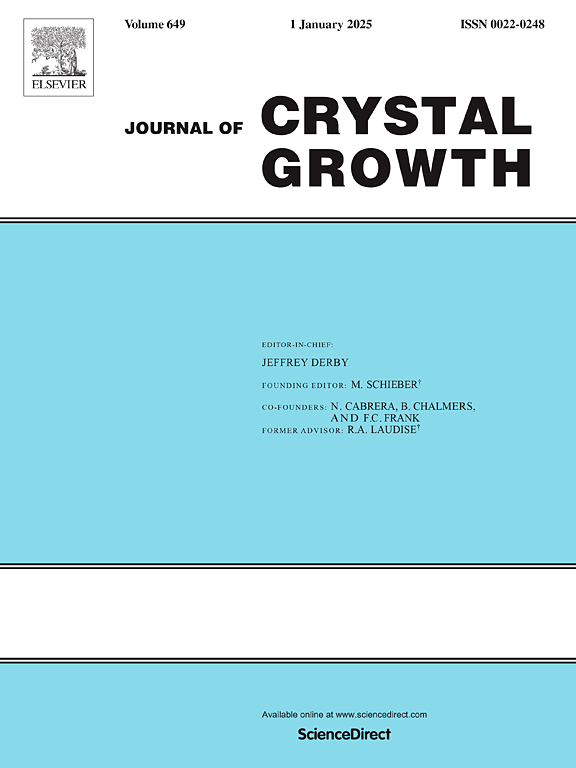chzochralski法生长Li2MoO4晶体的热应力和波状外形影响因素的三维数值研究
IF 2
4区 材料科学
Q3 CRYSTALLOGRAPHY
引用次数: 0
摘要
采用三维(3D)模型研究了用于构建热闪烁低温热辐射计(hscb)核心的Li2MoO4 (LMO)晶体在Czochralski生长过程中的传热、对流和热应力。几个直径为4厘米和5厘米的晶体以两种不同的查克拉尔斯基构型生长。在电感线圈和铂坩埚耦合的熔炉中生长的最大的铸锭(直径4厘米,长度6厘米)由于晶体底部被切割而破裂。另一种晶体(直径5cm,长度15cm)是基于电纳感应加热在炉中生长的,该晶体先前通过数值模拟进行了优化,以降低LMO晶体中的热应力。这锭的外表面呈微波状。这种不规则形状的研究考虑了熔体自由表面的三维对流效应,对流效应会影响液体半月板形状,并产生轻微的生长过程不稳定性。通过改变晶形自动控制的灵敏度,可以避免这种波形。对直径为4cm的铸锭进行了热应力计算,结果表明,铸锭纵向截面的法向应力最大,在铸锭底部的一个区域,法向应力大大超过了拉应力的临界值。这就解释了在切割锭尾时观察到的断裂。以5cm直径的铸锭为例,在优化结构下生长的计算表明,晶体表现出较低的热应力,除了位于铸锭外围的2mm薄区域,应力略高于临界值。通过使钢锭平行于c轴生长,热应力可降低1 / 2。本文章由计算机程序翻译,如有差异,请以英文原文为准。
3D numerical investigation of the factors affecting the thermal stresses and the wavy external shape of Li2MoO4 crystals grown by the Czochralski method
Three-dimensional (3D) modeling was applied to investigate heat transfer, convection and thermal stresses in Czochralski growth of Li2MoO4 (LMO) crystals used to build the core of heat-scintillation cryogenic bolometers (HSCBs). Several crystals of and in diameter were grown in two different Czochralski configurations. The largest ingot (-diameter and -length) grown in a furnace based on coupling the inductive coil and a platinum crucible, has cracked as the bottom part of the crystal was cut. Another crystal (-diameter and -length) was grown in a furnace based on inductive heating of a susceptor, which was previously optimized by numerical modeling in order to reduce the thermal stresses in LMO crystals. The external surface of this ingot shows a slightly wavy shape. This irregular shape was investigated by considering 3D convective effects at the free surface of the melt, which can affect the liquid meniscus shape, and generate slight instabilities of the growth process. It is concluded that this wavy shape can be avoided by changing the sensitivity of the automatic crystal shape control. The thermal stress computations, conducted for the ingot of in diameter, show that the normal stress in the longitudinal section has a maximum which highly exceeds the critical value of the tensile stress in a region located at the bottom part of the ingot. That explains the fracture observed during the cutting of the ingot’s tail. The computations performed in the case of -diameter ingot, grown in an optimized configuration, show that the crystal exhibits low thermal stress, except for a thin region of located at the ingot periphery, where the stress slightly exceeds the critical value. Thermal stresses can be reduced by a factor of 2 by growing the ingots parallel to the c-axis.
求助全文
通过发布文献求助,成功后即可免费获取论文全文。
去求助
来源期刊

Journal of Crystal Growth
化学-晶体学
CiteScore
3.60
自引率
11.10%
发文量
373
审稿时长
65 days
期刊介绍:
The journal offers a common reference and publication source for workers engaged in research on the experimental and theoretical aspects of crystal growth and its applications, e.g. in devices. Experimental and theoretical contributions are published in the following fields: theory of nucleation and growth, molecular kinetics and transport phenomena, crystallization in viscous media such as polymers and glasses; crystal growth of metals, minerals, semiconductors, superconductors, magnetics, inorganic, organic and biological substances in bulk or as thin films; molecular beam epitaxy, chemical vapor deposition, growth of III-V and II-VI and other semiconductors; characterization of single crystals by physical and chemical methods; apparatus, instrumentation and techniques for crystal growth, and purification methods; multilayer heterostructures and their characterisation with an emphasis on crystal growth and epitaxial aspects of electronic materials. A special feature of the journal is the periodic inclusion of proceedings of symposia and conferences on relevant aspects of crystal growth.
 求助内容:
求助内容: 应助结果提醒方式:
应助结果提醒方式:


